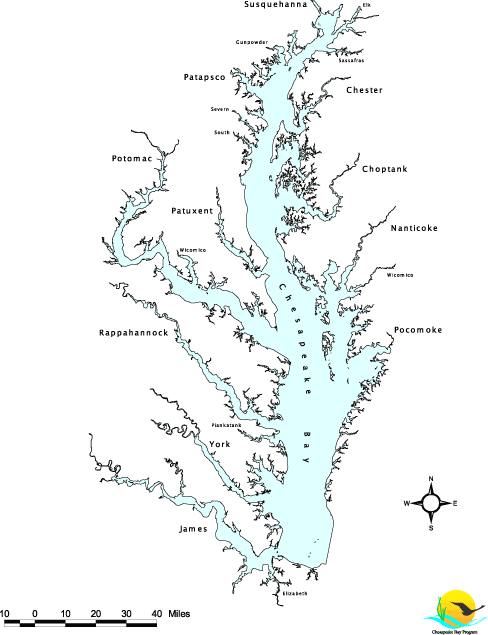http://www.cbf.org/
Brief History of the Chesapeake Bay Foundation
Founded in 1967, the Chesapeake Bay Foundation (CBF) is the largest privately funded, non-profit organization dedicated solely to protecting and restoring the Chesapeake Bay.
Since first rallying behind its slogan, "Save the Bay," CBF has grown to more than 216,000 members and 177 full time staff.
Mission & Goals of the Chesapeake Bay Foundation
CBF's mission is to restore and sustain the Bay's ecosystem by substantially improving the water quality and productivity of the watershed and to maintain a high quality of life for the people of the Chesapeake Bay region. To achieve its mission, CBF seeks to reduce pollution, restore habitat and replenish fish stocks, and educate and engage constituents to take action for the Bay.
CBF measures the health of the Bay in its annual State of the Bay Report by evaluating 12 key health indicators: wetlands, forested buffers, underwater grasses, resource lands, toxics, water clarity, phosphorus and nitrogen, dissolved oxygen, crabs, rockfish, oysters and shad.
In 2009, CBF rated the overall health of the Bay at a 28 out of 100 (100 representing a "pristine" Bay, circa 1600).
CBF's long-term goal is to see the Bay's health score 70 on our health index by 2050.
Operations of the Chesapeake Bay Foundation
CBF is a member-supported organization overseen by a volunteer board of directors. The staff includes William C. Baker, president, and vice presidents of its six departments: Environmental Protection and Restoration, Environmental Education, Communications, Finance, Administration, and Development.
CBF's headquarters is The Philip Merrill Environmental Center in Annapolis, Maryland (one of the world's "greenest" office buildings). CBF has state offices in Annapolis, Maryland, Richmond, Virginia, and Harrisburg, Pennsylvania, as well as field offices in Norfolk, Virginia, Salisbury, Maryland, and Washington, D.C.
CBF has 15 field programs (including four overnight education facilities), a fleet of education vessels (including the 100-year-old historic skipjack Stanley Norman), and mobile canoe rigs.
CBF works to Save the Bay in three key areas: environmental protection and restoration, environmental education, and communications.
Environmental Protection and Restoration conserves the Bay's natural resources by fighting for strong and effective laws and regulations. It protects the Bay and its tributaries from pollution and other harmful activities, and restores the Bay's vital natural systems like oyster reefs, forests, and wetlands through innovative projects.
Environmental Education inspires students and adults to become life-long stewards of the Chesapeake Bay. CBF's education program is the largest regional field-based environmental education program in the world. Each year, more than 40,000 students take part in CBF's comprehensive education activities.
Communications “builds the army” of advocates for the Bay and its rivers and streams. Through media coverage, a website, and electronic and print publications, Communications spreads the Save the Bay message to millions of residents in the six-state Bay region and beyond.
Budget & Finances of the Chesapeake Bay Foundation
CBF is 501(c)(3) not-for-profit organization privately funded by its members, individual and corporate donors. Its operating budget is $23 million.
Major Tributaries of the Chesapeake Bay - Map
Chesapeake Bay Foudation information sourced from http://cbf.org/Page.aspx?pid=929 and http://cbf.org/Page.aspx?pid=589

No comments:
Post a Comment